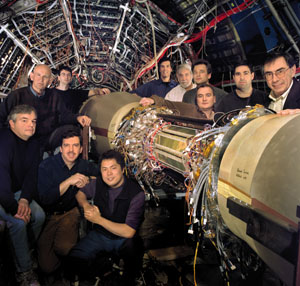
Recently Brookhaven’s RHIC (Relativistic Heavy Ion Collider) achieved another major milestone with the insertion of the Silicon Vertex Tracker (SVT) into the heart of the Solenoidal Tracker At RHIC (STAR) detector.
Since the RHIC start-up, people have consistently admired the beautifully complex images of high-energy gold ion collisions provided by the STAR Time Projection Chamber. The images from STAR’s first run were remarkable, and the data provided led to a wealth of early scientific results. But for the experts there was still something missing – information on the particle tracks close to the colliding beams.
That blank space in the tracking coverage of STAR is about to be filled with information provided by the Silicon Vertex Tracker, a state-of-the-art instrument which is based on silicon drift technology and was developed at Brookhaven. The completion of the STAR SVT is the culmination of an eight-year research and development effort by a team of more than 50 people, sponsored by the Office of Science of the US Department of Energy. Other institutions collaborating on the project include Wayne State University, Ohio State, the University of Texas and Lawrence Berkeley National Laboratory.

The SVT consists of three concentric layers of silicon drift detectors at 5 cm, 10 cm and 15 cm from the beam. These record the passage of charged particles in time and space, providing important information which can then be used in the STAR global tracking software. This allows for the detection of charged particles that decay quickly or curl up in the magnetic field before reaching the STAR Time Projection Chamber.
According to SVT project leader Rene Bellwied of Wayne State: “The installation of the SVT will provide essential tracking information to allow the detection of particles with short lifetimes, such as the cascade and the omega. It will also afford STAR an important low momentum tracking capability that it hasn’t had until now.”
Silicon drift detection is a new semiconductor technology developed in the mid-1980s by Brookhaven physicist Pavel Rehak in collaboration with Emilio Gatti from Milan. It was employed in the design of the SVT, allowing for a thirty-fold increase in space resolution compared with the TPC. This is necessarily close to the interaction point because of the high density of charged particle tracks produced when the gold ions collide.
The SVT will be commissioned this year when RHIC starts colliding beams of gold ions late in the spring.





